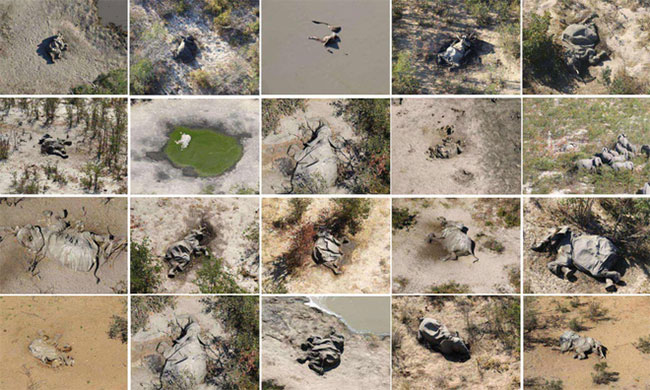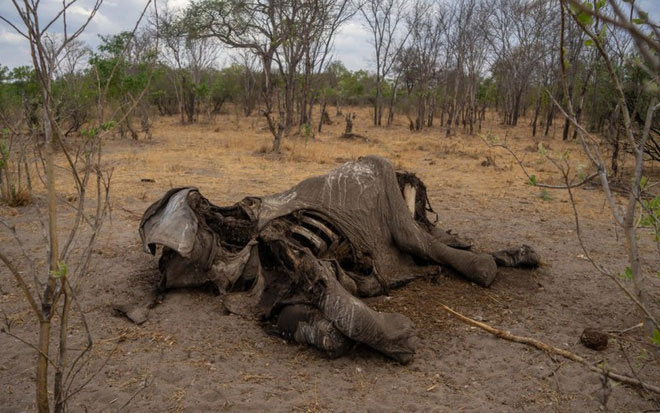Hundreds of elephants died mysteriously, unprecedented catastrophes caused scientists to panic
Elephants are currently one of the endangered species that need to be protected in the IUCN Red List (International Union for Conservation of Nature) . For years, authorities have struggled to fight poaching, shrinking habitats, as well as many other abusive acts that humans treat elephants.
However, the conservation of elephants in Africa is in an unprecedented catastrophe, when scientists recorded more than 350 elephants died mysteriously dead in Northern Botswana.

Summary of mysterious dead elephants recently. (Photo: The Guardian).
Specifically, at the beginning of May, a group of elephants was found dying in the Okavango plains, with more than 169 gone by the end of the month. By mid-June, the number more than doubled, with 70% dying near water holes.
"This is an unprecedented mass loss of elephants for a long time. Apart from severe droughts, I do not know which event has caused this serious mass death," said Dr. Niall. McCann, conservation director of the charity National Park Rescue (UK).
The Botswana government has not yet been tested, so there is currently no information on the cause of the disaster, as well as whether it will harm humans. Scientists make two hypotheses: poisoning, or a mysterious pathogen. The anthrax hypothesis - which often causes elephants to die in mass - has been rejected.

The body of an elephant recorded in early June.
"We have a mass death of elephants near the place where humans live in the context of wild animals being a concern (because Covid-19), but it seems that the government has not investigated or sent samples yet. to reputable laboratories " - McCann said.
Mysterious action before death
Local witnesses said they saw the elephants walking in a circle - a sign of disorientation , showing mental weakness. "When looking at the corpses, some of them died in a posture to the ground, indicating that they died very quickly. Others died more slowly, like elephants walking in a circle. So now, It's difficult to identify what kind of toxin this is " - McCann shared.

Many elephants died beside the water holes.
The dead elephants have no classification, spread across all ages and in both genders. Currently, many elephants are showing signs of weakness, emaciation, emaciation and emaciation, forecasting the increase in the number of dead elephants over the next few weeks. In fact, conservationists say the number of dead elephants is expected to be higher than the recorded numbers, because the carcasses of the elephants are difficult to detect.
Cyanide toxicity (cyanide) - commonly used by Zimbabwe poachers is also a possibility. However, it should be noted that scavengers still remain unharmed after eating elephant carcasses. Local media reported fewer vultures than to be expected, but all of them showed no signs of anomalies.
"There is no basis to conclude this is a natural disaster until the test" - McCann shared. Some people think of Covid-19, but this hypothesis is also very unlikely.
Disaster conservation
Currently, the Okavango Plain has about 15,000 elephants, accounting for 10% of the total number of elephants in Botswana. These elephants contribute significantly to Botswana's ecotourism industry, which accounts for 10% - 12% of the country's GDP, second only to diamond mining.
"Elephants are a property of this country. They are like mobile diamonds in the Okavango plains," McCann said. "It is truly a conservation disaster, when the country cannot protect its most valuable resources".
Elephants' carcasses remain intact, and conservationists are urging authorities to protect them, so poachers won't benefit. In neighboring countries, no similar incidents have been reported.

The dead elephants have no classification, spread across all ages and in both genders.
"The delay in getting samples to the lab to determine the cause and the solution is a cause for concern" - quoted Mary Rice, executive director of the Environmental Investigation Agency in London (UK). .
"The lack of urgency does not indicate the responsibility of the supervisor. There have been many offers of help from testing facilities, but no one cares. Meanwhile, the number of dead elephants is increasing dramatically." scary".
Dr Cyril Taolo, director of Botswana's Department of Wildlife and National Park, said: "We know that elephants are dying. Of the 350 individuals we reported, we confirmed 280, and are proceeding. note confirming the rest ".
"We have sent samples to test, and the results will come in the next few weeks" - he shared. "The movement restrictions because Covid-19 made it difficult to collect and ship samples. We have to adapt, and now we are moving the samples to other laboratories."
Taolo declined to disclose the identities of the laboratories responsible for this problem.
- Why is it difficult to see elephants confirm?
- Dozens of elephants died from poisoning
- Hundreds of forest elephants were massacred in Cameroon
- The phenomenon of mysterious dead birds in China
- Close-up of the savage slaughter that killed Dalat's elephant
- Hundreds of people died and went missing because of floods in Korea
- Elephants are extinct?
- Venom is not scary
- Indonesia: Three Sumarta elephants died of poisoning
- Fear of honey bees of African forest elephants
- 'The oldest elephant in North America died
- Scientists call for conservation of Vietnamese elephants
 Animal 'suffering' after hibernation
Animal 'suffering' after hibernation Why do goats climb well?
Why do goats climb well? Scientists were surprised to see chimpanzees eating turtles
Scientists were surprised to see chimpanzees eating turtles Giant catfish died deadly due to drought in Thailand
Giant catfish died deadly due to drought in Thailand